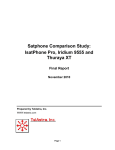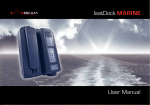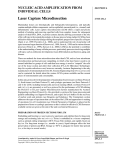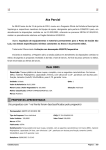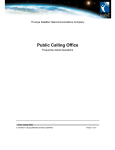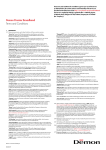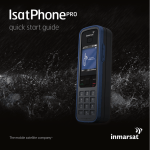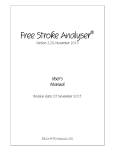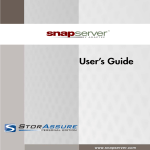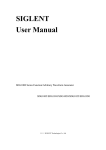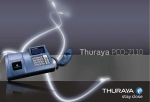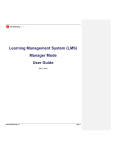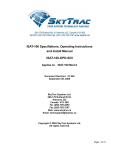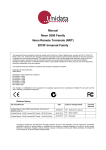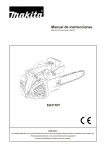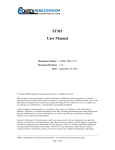Download Satellite Phone Comparison Study Final Report
Transcript
Satphone Comparison Study: IsatPhone Pro, Iridium 9555 and Thuraya XT Final Report November 2010 Prepared by TelAstra, Inc. WWW.telastra.com Page 1 Table of Contents Page TelAstra Inc 3 Executive Summary & Conclusions 4 Background 12 Specific Test Methodology and Results 12 1. Global Coverage 14 2. Robust Handset 15 3. Clear Voice Quality 16 4. Reliable Network Connection 17 5. Long battery life 19 6. Easy to use 22 Other services 25 7. SMS texting 25 8. Data 26 Appendix A: Mechanical Stress Testing Page 2 27 TelAstra, Inc. TelAstra, Inc. is an international telecommunications consulting firm that primarily provides consultation to investors in satellite communications. The firm was established in 1985 and has a broad background in engineering, business, and commercial aspects of satellite communications. The principal investigators for this study have experience in satellite communications stretching back to the mid 1960s. Roger Rusch was involved with producing the first generation of satellite facilities for mobile communications and holds several early patents in non-geostationary mobile satellite designs. Mr. Rusch was the founder of the TRW Odyssey system that was adopted by ICO. Charles (Chuck) Emmert also has nearly 50 years of experience in satellite communications. He is a pioneering expert on satellite business services that have become known as VSAT or private networks. This is the third major report on mobile satellite communications prepared by TelAstra, Inc. In the past decade, TelAstra, Inc. has published two reports sponsored by the European Space Agency. The staff of TelAstra, Inc has used satphones starting with the inception of mobile satellite service in the 1980s including Inmarsat, Iridium, and Globalstar products. Page 3 Executive Summary Inmarsat commissioned TelAstra to assess the IsatPhone Pro, Iridium 9555 and Thuraya XT against each one‟s published claims in six areas that Inmarsat describes as the “ultimate combination.” These are: 1. 2. 3. 4. 5. 6. Global coverage Robust handset Clear voice quality Reliable network connection Long battery life Easy to use TelAstra, Inc. evaluated the three satphones over a period of two months in 16 locations around the world. The Ultimate Combination 1. Global coverage Inmarsat: TelAstra can confirm Inmarsat‟s global coverage claims. IsatPhone Pro worked well in all locations. We obtained strong connections for IsatPhone Pro in Anchorage and Fairbanks, Alaska and northern Finland near the Arctic Circle – all areas moving towards edge of coverage. IsatPhone Pro worked well near the equator and in mid-latitude locations as well. Iridium: Our tests show that the Iridium satellite network is global. However, its universal service claim ignores the fact that coverage is often denied or disconnected near partial foliage and buildings. In reality, the Iridium system probably provides less coverage of the Earth at any time because the Iridium satellites are typically at a low elevation angle and transmission is blocked. Our experience is that longer calls on Iridium 9555 typically suffer disconnects, probably because the satellites are moving. Thuraya: Although the Thuraya system is regional, we found that within the regions that it covers the service was similar to that provided by IsatPhone Pro. 2. Robust handset The IsatPhone Pro is clearly the most robust of the three satphones that we examined. The Thuraya XT suffered damage to its antenna in mechanical drop tests. Iridium 9555 suffered the most extreme damage and was not functional after the random drop test. Failures occurred in antennas that protrude from the main phone body even when stowed. 3. Clear voice quality Clarity and recognition IsatPhone Pro: Reports from listeners were that the voice was clear and “better than cellular.” When listening to recordings of the phone calls on an answering machine, the clarity sounded somewhat better with this phone, and there was usually less background noise. Page 4 Iridium 9555: The most frequent comment we heard was “sounds like in a tunnel.” Overall the voice quality of the Iridium 9555 under the best conditions was usually similar to the IsatPhone Pro, but sometimes we experienced terrible call quality. Thuraya XT: This phone produced a voice quality that was slightly inferior to the other two phones. We encountered more connections where the voice was garbled or somewhat distorted. Even in the best calls the overall quality was not as good. Latency Latency for all of the satphones is similar and greater than for landlines or cellular communication. We noticed that for all 3 satphones, some calls had significantly greater latency than others. We speculated that this related to call routing. Background noise Each of the phones exhibited some degree of background noise from time to time that was generally distinctive to that phone model. We found that the background noise was lowest on the IsatPhone Pro. 4. Reliable network connection Connection to the network IsatPhone Pro: We timed the initial acquisition and GPS fix of the IsatPhone Pro to be 72 to 120 seconds. After that setup, the antenna can be stowed and the phone set aside for an extended period. When the next attempt is made, the IsatPhone Pro will reacquire in 10 to 34 seconds. Inmarsat informed us that the GPS fix is held in the phone for three or four hours before needing a repeat location determination. Inmarsat also informed us that this acquisition process is something that may be improved. At the time of testing the IsatPhone Pro service had only been in service for four months. Iridium 9555: The Iridium 9555 phone does not obtain a GPS fix and will routinely acquire the satellite and be ready for dialing in 31 to 40 seconds. This process takes longer, of course, if the signal is obstructed or the network is not available. When the network unavailability is taken into consideration, the average Iridium acquisition time may actually be longer than for IsatPhone Pro or Thuraya XT. Thuraya XT: The Thuraya XT seems to acquire quickly if the network is available. Sometimes it seems that a call can be placed even before the display says the satellite is acquired. Thuraya seems to perform its GPS functions in the background. Network availability We assessed the availability for IsatPhone Pro and Thuraya XT to be essentially 100%. The only requirement is to find and maintain a clear transmission path. On several occasions we had to wait for 5 to 12 minutes to connect to the Iridium network. Iridium 9555 seems to drop out frequently in certain environments. Since the satellites are moving in orbits that are typically unknown to the phone user, it is unlikely that a user can provide any form of “cooperation” that would reduce blockage. Page 5 Call reliability The IsatPhone Pro is remarkably stable when satellite network is acquired. We seldom experienced a disconnect with the IsatPhone Pro. In our experience, it seems impossible to have an extended call on Iridium 9555 without interruption. We repeated the walks around Palos Verdes, Los Angeles County, California and experienced four disconnects in 20 minutes. Occasionally, we found the network simply disappears. Our experience was that most of the time the Iridium service is hit or miss. We were surprised many times that we could not receive a signal in an apparently open environment. Other times the signal was steady for an hour at a time with no interruptions. The Thuraya XT performance in prime areas of coverage was similar to the IsatPhone Pro. 5. Long battery life Although the numbers are not precise, the capacity of each phone is relatively the same as claimed. IsatPhone Pro has significantly more capacity than the Iridium 9555 or Thuraya XT phones. Claimed Talk time Measured Talk time Claimed Standby time Measured Standby time IsatPhone Pro Iridium 9555 Thuraya XT 8 hrs 7 hr. 45 min. 100 hrs 84 hrs 4 hrs 5 hr. 6 min. 30 hrs 30 hrs 6 hrs 6 hr. 19 min. 80 hrs 38 hr 30 min Figure 1. Relative battery capacity 6. Easy to use This is a very subjective area. Where possible, we have tried to quantify our findings. Setting up the IsatPhone Pro only took nine minutes to unpack, install its SIM card, and set up the battery for charging. Setting up the Iridium 9555 was very short since this was a rented phone with SIM card and battery already installed. The mechanical setup time for Thuraya XT was short, but the administrative time to register with the network and be approved for use was long. All 3 satphones have quick start and user manuals, in either paper or CD format or both. Both the IsatPhone Pro and Thuraya XT use fairly standard conventions for handset operation. The phone turns on and off by holding down the red phone key. The Iridium 9555 has a separate on-off switch on the top of the handset. The keyboards for both the Iridium 9555 and IsatPhone Pro have sufficiently large key separation that a thumb or gloved hand can key in numbers with ease. The Thuraya XT is the smallest, but the keyboard is tiny and the key spacing is tight. It works best with the use of a thumbnail or stylus to key in the numbers. Thuraya XT seems to have the brightest display screen, but all are difficult to see in bright sunlight. Iridium 9555 is a challenge in dim light or in the evening as it has a monochrome screen. Page 6 The menus on all of the satphones use icons. IsatPhone Pro has a straightforward structure that includes choices on display illumination and remaining battery capacity. We thought that the Iridium 9555 had a relatively simple menu structure although with few choices. We thought the Thuraya XT had the most colorful menu with a number of interesting choices. The IsatPhone Pro is the only one of the 3 satphones to have a Bluetooth connection but all three have wired headsets for hands-free operation. The IsatPhone Pro has a loudspeaker feature. The Thuraya XT fits easily into a suit or coat pocket. Iridium 9555 and IsatPhone Pro require a slightly larger pocket. All of them are convenient to hold while talking or walking. SMS texting is available on all three phones. IsatPhone Pro and Thuraya XT follow the standard cellular method of texting. The ability to function and send text-to-text and text-to-email messages were tested using the IsatPhone Pro and Iridium 9555 satphones with no appreciable difference observed. However, for the Thuraya XT we never got the opportunity to test the “text-to-email” and “Web message-toSatphone” functions because we had great difficulty using the Thuraya service in Zimbabwe where these tests were performed. A review of the various specifications shows that all three satphones have similar capability to send and receive messages. On the surface we could not see any noteworthy differences. The Iridium 9555 and Thuraya XT offer low rate data services on their satphones. A firmware upgrade that Inmarsat says it will introduce in Q1/2011 will add low speed data to the IsatPhone Pro. Page 7 IsatPhone Pro Iridium 9555 Thuraya XT Global Performed well in all locations Global Periods on no network availability Regional Performed well in all locations in region Robust Handset Most Robust IP54 certified Least Robust No IP rating stated Robust IP54 certified Clarity & Recognition Frequently reported better than cellular Frequently reported distortion with caller not recognizable Occasionally garbled or distorted Latency Tolerable Tolerable Tolerable Background noise Least Some Some Time to Acquire Longest Shortest when available Intermediate Network Availability Virtually 100% Periodic interruptions Virtually 100% Call reliability Extremely stable Frequently dropped calls Stable in prime coverage areas Measured Talk Time Specification 7hr 45 min 8 hrs 5 hr 6 min 4 hrs 6 hr 19 min 6 hrs Measured Standby Specification 84 hrs 100 hrs 30 hrs 30 hrs 38 hrs 30 mins 80 hrs Set-up and Registration 9 min Not applicable on rental handset Several hours to register & make first calls successfully Instruction manual CD ROM & manual CD ROM CD ROM & manual Making a call Easy Easy Easy Keyboard Large, easy to use Large, easy to use Too small for comfort; Input error prone Display Adjustable font Prefer larger font Fixed font Black & White; difficult to read Adjustable font Brightest; full color; Easiest to read Menus Easy to use Simplest to use but limited Easiest to use Most extensive Bluetooth Yes No No Wired Hands Free Yes, worked well Yes, worked well Yes, worked well Loudspeaker Yes No No Size & Weight Comfortable Comfortable Smallest Characters 1600 1000 Multi-page Text-to-text Yes Yes Yes Text-to-email Yes Yes Yes Other Text GPS position Free text from website Free text from website SMS Texting Easy to use Long Battery Life Reliable Network Connection Clear Voice Quality Coverage Figure 2. Overall Comparison of Satphones The 3 Satphones compared All the satphones have pluses and minuses. All of them would be acceptable with various limitations. Each one works in a different way. We observed that each of the Page 8 satphones performs differently from call to call in terms of connect time, disconnects, and voice quality, even apparent latency. Sometimes one party can hear a great voice quality while the other gets fuzzy sound quality with break-ups, fragments, and distortion, or cannot be heard at all. IsatPhone Pro: Our tests have corroborated the claims for the IsatPhone Pro (Figures 2 & 3). This satphone works very well in all locations. It provides global coverage to all but the extreme polar regions. IsatPhone Pro was the most robust. It provides excellent voice quality. We were impressed with the ability of the system to maintain connection even when moving through regions of obstruction. The IsatPhone Pro battery capacity is markedly greater than its competitors. The opinion of several listeners was that its voice quality sounds better than cellular. We concluded that its voice quality was consistently superior to the other two phones. It is easy to use after you understand how to set up a clear line-of-sight link. We did not find any features of other phones that were significantly better than the IsatPhone Pro. IsatPhone Pro Typical Performance 1 Global coverage Works everywhere, including central Alaska, North Finland 2 Robust handset Most rugged based on a series of mechanical stress tests 3 Clear voice quality 4 Reliable network connection 5 Long battery life 6 Easy to use Excellent, voice recognizable, latency tolerable Solid network connection Higher battery capacity & longer life than competitors Keys like cellular, menus understandable Figure 3. IsatPhone Pro performance The IsatPhone Pro performs very well. For prospective users of the IsatPhone Pro, it may be worth considering that this is a brand new service: new satphone, new ground network, and a new service that was launched on 30 June 2010. The Inmarsat-4 satellites, which are used for the satphone service, were launched between 2005 and 2008 and have an expected lifetime into the 2020s. We consider that the IsatPhone Pro performance could be improved by a software solution that would significantly shorten the time to set up and place a call. We cannot be too specific about how to do this because we do not fully understand the design constraints. We found that the service quality of the Inmarsat IsatPhone Pro is excellent. No doubt refinements will be incorporated as time goes by. Iridium 9555: The Iridium network is global. We found that the Iridium 9555 is not nearly as rugged as the IsatPhone Pro. It fell apart in standard tests that are commonly used by the cellular phone industry. Overall the voice quality of the Iridium 9555, under the best conditions, was usually similar to the IsatPhone Pro but sometimes we experienced terrible call quality. If there is an Iridium satellite signal available, it is easier and faster to set up a call with the Iridium 9555 than the other two satphones. Since the Iridium network includes a constellation of 66 satellites in Low Earth Orbit (LEO), the satellites are typically near the horizon. The elevation angles can be as low as 8º above the horizon. The instructions tell the user to move to an open area. However, it is Page 9 extremely difficult to find an open area without some obstacles greater than 8º high. Not many places are completely clear across the sky. Realistically locations with obstructions are more typical. In testing we found that the Iridium availability varied from only 70% to 90% in areas with low buildings, small trees, or shrubs. Availability is lower in areas with tall buildings or obstructions. There were frequent call drops in tests with a moving phone. We encountered at least 22 dropped calls with the Iridium 9555 compared to only 5 dropped calls with the IsatPhone Pro. We experienced a number of cases of poor voice quality when using the Iridium 9555 that were inferior to cellular service. In the process of recording calls on an HD camcorder, we have collected several video clips that illustrate waiting for 5 to 12 minutes to connect to the Iridium network under conditions where IsatPhone Pro and Thuraya XT connected in less than two minutes. We found Iridium‟s claims on battery life to be either accurate, or slightly understated. The Iridium 9555 was easy to set up. The keyboard was easy to use but the monochrome screen was difficult to read in dim light. Iridium 9555 Typical Performance 1 Global coverage Works everywhere; but network not always available. 2 Robust handset No IP rating quoted; performed most poorly in a series of mechanical stress tests In ideal conditions, fine; sometimes terrible Fastest to connect if network available; dropped calls frequently Standby time as claimed; talktime appeared to be better than claimed Easy to set up. Nice sized keyboard; monochrome screen difficult to read in dim light 3 Clear voice quality 4 Reliable network connection 5 Long battery life 6 Easy to use Figure 4. Iridium performance In our view the Iridium 9555 would benefit from a design update that would improve structural robustness, provide a better display, and more menu features. Furthermore, it is our opinion that the Iridium network should be enhanced to provide higher availability in high latitudes where we experienced very poor service. Thuraya XT: Thuraya offers a regional service. The Thuraya XT is not as robust as the IsatPhone Pro. It has an IP54 rating. It suffered damage to its antenna in the random drop tests but passed the guided free fall tests. We found the voice quality was slightly inferior to the other two satphones. The Thuraya XT seems to acquire the satellite quickly if the network is available. In our experience, administrative processes for Thuraya XT are frustrating. Activation into the system, service support, and adding prepaid minutes were significantly more difficult for Thuraya XT. It took 28 calls over a six-hour period to place our Thuraya phone into service in Japan. We also had great difficulty using this phone in Zimbabwe. When the minutes on the prepaid card were exhausted, the phone reported that it had failed. It was not obvious that the pre-paid time had expired, so there was a great deal of frustration and delay before minutes could be added. We found that battery life talk-time was slightly better than claimed but standby time somewhat shorter. Page 10 The Thuraya XT phone is somewhat smaller than the IsatPhone Pro and the Iridium 9555 and fits in a coat or suit pocket, but its keys are closely spaced and subject to entry errors. Thuraya XT Typical Performance 1 Global coverage Regional service, as claimed 2 Robust handset IP54 rating quoted; not as robust as the IsatPhone Pro during a series of mechanical stress tests Slightly inferior to IsatPhone Pro and Iridium 9555 Acquires the satellite quickly. Registration and support poor Standby time seemed considerably less than claimed; talktime appeared to be slightly better than claimed Small size makes it very easy to carry. Small keys cause keyboard entry errors. Bright color screen. 3 Clear voice quality 4 Reliable network connection 5 Long battery life 6 Easy to use Figure 5. Thuraya XT performance We think that the Thuraya XT would benefit from a more simplified process for obtaining initial access to the network and a keyboard with wider spaced keys. Conclusions All of the phones are acceptable for communications wherever we tested and the operator provides service. None of the phones provides perfect communications. The quality of satphone service is always inferior to wired service using the PSTN. However, satphone service is actually comparable to other wireless services like cellular. Often the IsatPhone Pro satellite service provides a clearer voice than cellular. TelAstra, Inc. was not asked to compare the price of the satphones or satphone services. Consequently, it would not be fair to evaluate relative pricing. However, based on our limited review, it appears that IsatPhone Pro prices are significantly less expensive, and the service rates appear to be highly competitive as well. Unquestionably IsatPhone Pro is the best and would be our choice regardless of affordability or any other single issue. It works everywhere and is the most rugged and the only satphone to pass all the mechanical stress tests. The voice quality is excellent, it has reliable network connection, and the longest battery life of all three satphones. It is also easy to use. Page 11 Background The use of communication satellites for mobile communications started in 1976. Inmarsat was formed in 1979. With the rapid expansion of cellular phone service, the idea of space-based satphones was promoted in 1990. Several of these early systems were designed to provide hand-held services from large constellations of satellites in Low Earth Orbit (LEO). Iridium and Globalstar started service in 1998 and 1999 respectively. Both of these systems went bankrupt because the capital and operational costs were far greater than the revenue that these extravagant systems could produce; both companies re-emerged from bankruptcy. By 2008 the two-way service of Globalstar was no longer functional. The Iridium system remains in operation long past its design life. The Thuraya system was placed in service in 2001 to provide service from geostationary orbit. Inmarsat‟s satphone, the IsatPhone Pro, was launched on 30 June 2010. There are two contemporary satphones available in this market: the Iridium 9555 and the Thuraya XT. Prior to IsatPhone Pro‟s launch, Iridium was the only global satphone system on the market. Thuraya is a well known, UAE owned regional satellite system that provides service to portions of Eurasia, Africa, and Australia but not the Americas. The new IsatPhone Pro has the potential of taking significant market share from both systems. Inmarsat commissioned TelAstra, Inc. to perform an independent, comprehensive comparison study of three satphones: IsatPhone Pro, Iridium 9555 and Thuraya XT. The study was to be based on each one‟s published claims in six areas which Inmarsat describes as the “ultimate combination.” Specific Test Methodology and Results Two test teams used two sets of Iridium 9555, Thuraya XT, and the IsatPhone Pro satphones to provide a wider set of experiences. The Iridium satphones were rented from an Iridium service provider; the Thuraya satphones were purchased from a U.S. based service provider and the Inmarsat satphones were loaned to us by Inmarsat. The two IsatPhone Pros were brand new, delivered as if we had purchased them. The study is based on field-testing at 16 locations around the world. Inmarsat specified 8 locations for testing that would validate the operation in optimum and marginal coverage areas for each satellite network. However, travel schedules and stops enabled the number of test locations to be expanded to 16 without significant additional effort: Anchorage, Alaska, USA Dubai, UAE Fairbanks, Alaska, USA Helsinki, Finland Johannesburg, South Africa Kaustinen, Finland Page 12 Lake Como, Italy London, United Kingdom Los Angeles, California, USA Milan, Italy New York, New York, USA West Palm Beach, Florida, USA Rome, Italy Singapore Tokyo, Japan Victoria Falls, Zimbabwe Tests performed from remote locations included any characteristics that could be affected by geographic locations or networks. These include voice quality (such as the ability to recognize callers), latency, availability, dropped calls, reliable network, and robust connection. Figure 6 categorizes the calls that were logged and recorded. Rusch Emmert Totals IsatPhone Pro Iridium 9555 Thuraya XT Totals 50 15 65 41 13 54 48 28 76 139 56 195 33.3% 27.7% 39.0% 100.0% Figure 6. Number of test calls by phone type We have documented more than 195 calls from 16 locations worldwide. Most of the calls were recorded on more than five hours of video files and in logs that comment on the call experience. We have encountered cold and hot test conditions from near the Arctic Circle, the Deserts of Arabia, tropical Singapore and southern Africa. We have worked in the rain. Some satphones have been dropped, and we have witnessed physical stress tests of the phones under laboratory conditions. We have attempted to provide quantitative measurements of performance wherever possible. Furthermore, we have formed subjective impressions of each satellite network and their satphone service over the test period. Extensive tests were undertaken at these locations. Many tests were performed in our business offices. The TelAstra, Inc. west coast operation is located in Palos Verdes, Los Angeles County, California. The east coast operations are in Palm City, Florida, 25 miles north of West Palm Beach. The two teams were able to communicate frequently throughout the testing period. Mechanical stress testing was performed and validated on 12 more phones at the Sasken Offices (designer of IsatPhone Pro) in Kaustinen, Finland (Appendix A). Testing of Iridium 9555 and IsatPhone Pro battery capacity tests were performed in our offices. Thuraya XT and some IsatPhone Pro battery capacity tests were performed in remote field tests. Page 13 The Ultimate Combination 1. Global Coverage Iridium: The Iridium system uses 66 satellites moving 775 km (482 miles) above the earth in polar orbits to provide continuous coverage of the entire globe. The satellites are always moving relative to the surface of the earth. The Iridium satellites typically appear near the horizon at elevation angles as low as 8º. Consequently, users sometimes do not have a clear line of sight to the satellites due to obstructions. The Iridium satellite network is global. However, its universal service claim ignores the fact that coverage is often denied or disconnected near partial foliage and buildings. In reality, the Iridium system probably provides less coverage of the Earth at any time because the Iridium satellites are typically at a low elevation angle and transmission is blocked. Our experience is that longer calls on Iridium 9555 typically suffer disconnects, probably because the satellites are moving. For instance, we were often able to get Iridium service in Alaska but not all of the time. Sometimes we had to wait for several minutes before a satellite signal was available. We sat at a picnic table for 45 minutes in an open area and recorded four periods of “searching for network” that lasted for a total of 9 minutes. We were surprised that the quality of service was relatively poor for the Iridium system in northern latitudes since the concentration of satellites is highest nearest the poles. Inmarsat: Inmarsat uses three geostationary satellites that are positioned to serve all of the earth except for the extreme polar regions. We can confirm Inmarsat‟s global coverage claims. IsatPhone Pro worked well in all locations. We obtained strong connections for IsatPhone Pro in Anchorage and Fairbanks, Alaska and northern Finland near the Arctic Circle – all areas near the edge of coverage. IsatPhone Pro worked well near the equator and in mid-latitude locations as well. IsatPhone Pro, like all satphones, requires a clear transmission path. However, once a suitable location is selected the satellite does not move and uninterrupted communication is possible in the middle of built-up areas, trees, or rocky terrain. Inmarsat coverage is shown in Figure 7. The specific orbit locations are as follows: Page 14 Inmarsat-4 AMER 98ºW Inmarsat-4 EMEA 25ºE Inmarsat-4 APAC 143.5ºE Figure 7. Inmarsat-4 Satellite Coverage Map & Test Locations Thuraya: Thuraya uses two geostationary satellites to cover most of Asia, Africa, Australia, the Middle East and Europe (Figure 8). Within the regions that it covers, the satellite service was similar to that provided by IsatPhone Pro in that the satellite is always present. The specific orbit locations are as follows: Thuraya 1/2 Thuraya 3 44ºE 98.5ºE Figure 8. Thuraya Satellite Coverage Map & Test Locations 2. Robust handset Satphones must be designed to survive the normal wear and tear of a mobile communications device. Sometimes mobile satphones are subjected to extreme thermal conditions. Both the Inmarsat and Thuraya phones claim that they meet the Page 15 IP54 standard1 for dust and water protection. Iridium does not quote an IP rating but claims to be rugged and robust. Inmarsat retained Sasken and VTT Expert Services Ltd to validate the standards of durability. For this evaluation, Sasken described the validation of the IP54 rating. Testing at Sasken Finland Oy in Kaustinen, Finland was designed to validate the robustness claims for the three satphones (Appendix A). These tests were performed over three days in October at the test facilities of Sasken in the presence of Roger Rusch from TelAstra, Inc. The IsatPhone Pro is clearly the most robust of the three satphones that we have examined. The Thuraya XT suffered minor damage to its antenna in mechanical drop tests. Iridium 9555 suffered the most extreme damage and was not functional after the test. Failures occurred in the antennas that protrude from the main phone body even when stowed. The IsatPhone Pro is less susceptible to damage because the antenna retracts within the phone body. 3. Clear voice quality The evaluation of voice quality is a subjective test and susceptible to environmental conditions. With unobstructed transmission to the satellite, perfect terrestrial network connection, and a solid cellular connection or landline connection, the conditions should be ideal for evaluation of satphone voice quality. These conditions do not always exist, and therefore we can expect some variability in the performance. The testers base this evaluation on repeated test calls and some judgment about the sound quality. As to be expected, it seems that the quality is best when the signal strength is strong and degrades with weak signals. The callers considered voice quality in terms of clarity and recognition, latency, and background noise. The call recipient was often the other test team. However, we also called friends and relatives who were willing to accept test calls. The satellite caller rated call quality, and we asked for the impression of the terrestrial call recipient in each case. We also recorded calls on voice mail (answering machine) for each call location. The impression of the caller and recipient were recorded for each call from each location. Since we made recordings, we have been able to return to the calls and listen again to the messages. Under ideal conditions, there were not great differences between voice quality of these three satphones. Clarity and recognition IsatPhone Pro: Reports from listeners were that the voice was clear and “better than cellular.” When listening to recordings of the phone calls on an answering machine, the clarity sounded somewhat better with this phone, and there was usually less background noise. Iridium 9555: The most frequent comment we heard was “sounds like in a tunnel.” Overall the voice quality of the Iridium 9555 was, under the best conditions, usually 1 Ingress Protection (IP) ratings are developed by the European Committee for Electro Technical Standardization (CENELEC) (NEMA IEC 60529 Degrees of Protection Provided by Enclosures - IP Code), specifying the environmental protection the enclosure provides. Page 16 similar to the IsatPhone Pro but sometimes we experienced terrible call quality. Signal strength and the signal to noise ratio or Bit Error Rate (BER) changes as an Iridium satellite passes overhead. This causes the voice quality to vary over time. The voice quality was terrible in some of the calls. Thuraya XT: This phone produced a voice quality that was slightly inferior to the other two phones. We encountered more connections where the voice was garbled or somewhat distorted. Even in the best calls the overall quality was not as good. Latency For this study TelAstra, Inc. did not have a means to measure latency precisely. Based on our testing experience, we have the impression that latency for all of the satphones is similar and greater than for landlines or cellular communication. However, cellular circuits also have significant delay, and users seem to have developed greater tolerance for latency over the years. In experiencing the satellite calls, we noticed that some calls had significantly greater latency than others. This was true for both the Iridium calls through LEO satellites and for IsatPhone Pro and Thuraya XT that use geostationary satellites. We speculated that sometimes the call is routed through additional satellite links, but there was no way to determine if this speculation was correct. Background noise One of the artifacts of all three satphones is background noise. Each of the phones exhibited some degree of background noise from time to time that was generally distinctive to that phone model. We found that the background noise was the lowest on the IsatPhone Pro. 4. Reliable network connection We defined reliable network connection as comprising three elements: connection to the network, network availability, and call reliability. The only way we found to test these aspects is by repeated use of the system in several locations. Connection to the network All satphones require unobstructed line of sight to the satellite. Satphone signals are not as powerful as cellular phone signals and cannot penetrate obstructions. Inmarsat‟s and Thuraya‟s satellites are geostationary and situated over the equator. Unless you have a superb sense of direction, it helps to have a compass and some prior knowledge of where to stand to ensure an unobstructed path to the satellite. Once the geostationary satellite signal is secured, network access is typically fixed as long as the user does not move into a shadowed space. The Iridium non-geostationary satellites move, and, consequently, signal acquisition may not be possible because of an unknown obstruction. A few minutes later, a satellite may move into a clear position. However, once the signal is acquired, the connection is volatile. It could be lost at any time due to an unknown blockage. We found that user cooperation is essentially meaningless other than trying to find a Page 17 totally unobstructed location, which is especially difficult in any areas with tall buildings and obstructions or even in areas with low buildings, small trees, or shrubs. The IsatPhone Pro normally requires a longer time to set up and place a call than Iridium 9555 or Thuraya XT. The call placement time is not consistent for any of the phones. Sometimes it is relatively quick. Sometimes the call does not go through and must be placed a second or third time. IsatPhone Pro requires a GPS fix which can add time and inconvenience. Under these circumstances, a call cannot be placed until the GPS calibration is completed. The user sometimes receives the instruction to “point at the satellite” and can benefit from knowledge of the satellite location. It is useful to know the rough location of the satellite.The key consideration is finding a position without blockage between the user and the satellite. Initial acquisition can require one or two minutes, but subsequent network searches are shorter. To be specific, we timed the initial acquisition and GPS fix of the IsatPhone Pro to be 72 to 120 seconds. After that setup, the antenna can be stowed and the phone set aside for an extended period. When the next attempt is made, the IsatPhone Pro will reacquire in 10 to 34 seconds. Inmarsat informed us that the GPS fix is held in the phone for three or four hours before needing a repeat location determination. Inmarsat also informed us that this acquisition process is something that may be improved. At the time of testing the IsatPhone Pro service had only been in service for four months. The Iridium 9555 phone does not obtain a GPS fix and will routinely acquire the satellite and be ready for dialing in 31 to 40 seconds. This process takes longer, of course, if the signal is obstructed or the network is not available. When the network unavailability is taken into consideration, the average Iridium acquisition time may actually be longer than for IsatPhone Pro or Thuraya XT. The Thuraya XT seems to acquire the satellite quickly if the network is available. Sometimes it seems that a call can be placed even before the display says the satellite is acquired. Thuraya seems to perform its GPS functions in the background. Network availability Geostationary satellites provide continuous service, and we assess the availability for IsatPhone Pro and Thuraya XT to be essentially 100%. The only requirement is to find and maintain a relatively clear transmission path. On several occasions we had to wait for 5 to 12 minutes to connect to the Iridium network. Iridium 9555 seems to drop out frequently in certain environments. Since the satellites are moving in orbits that are typically unknown to the phone user, it is unlikely that a user can provide any form of “cooperation” that would reduce blockage. The Thuraya XT operational characteristics are about the same as for the IsatPhone Pro since both systems use geostationary satellites. We had difficulties using the Thuraya phone in Zimbabwe where coverage is marginal. Setting up service and being recognized by the system required a number of call attempts. Reaching the Thuraya help desk required the use of the IsatPhone Pro. Page 18 Call reliability Typical cellular call records show the average cellular call to be two to three minutes in duration. Calls are often longer for satphone users who use the service for business purposes, however. It also seems logical that satellite calls would be longer because of the nature of remote businesses. The IsatPhone Pro is remarkably stable when satellite network is acquired. We seldom experienced a disconnect with the IsatPhone Pro. We routinely talked while walking around Palos Verdes, Los Angeles, for 20 minutes or more. We had two 1.5hour and one 2.5-hour uninterrupted stationary calls during the battery capacity tests. Once the signal is locked in place, it is secure. The display can be monitored to ensure that the signal strength is high enough. It seems impossible to have an extended call on Iridium 9555 without interruption. We had repeated the walks around Palos Verdes and experienced four disconnects in 20 minutes. Occasionally, we found the network simply disappears. Since the signal availability is not stable, it is difficult to differentiate between a blockage situation and an actual network defect such as a satellite failure or missing beams from the satellite. We have encountered several outages as long as 12 minutes. The loss of signal in open terrain makes the test team question whether there are holes in the Iridium coverage. Our experience was that most of the time the Iridium service is hit or miss. We were surprised many times that we could not receive a signal in an apparently open environment. Other times the signal was steady for an hour at a time with no interruptions. We performed more than a dozen hour-long observations of Iridium network connections. In a typical area with low buildings, small trees, or shrubs, we found that the availability varies from 70% to 90%. Availability is much lower in areas with tall buildings or obstructions. Initially we were not able to find a signal in Johannesburg, South Africa. We experienced a number of disconnects on longer calls. We were surprised that the quality of service was relatively poor for the Iridium system in northern latitudes since the concentration of satellites is highest near the poles. The Thuraya XT performance in prime areas of coverage was similar to the IsatPhone Pro. 5. Long battery life Obtaining a precise value for battery life is more difficult than we expected. It has been hard to establish a consistent set of test conditions that capture a precise number of hours. According to Inmarsat Customer Services: "Battery life is affected by a number of factors which include how many calls are made and how long each is, where you are on the earth (it takes more power to make a call at the edges of coverage than it does if directly under a satellite). The 8 hours talk time quoted [for IsatPhone Pro] is for one continuous phone call in a location that is neither under the satellite nor at the edge of coverage. Inmarsat has also conducted tests in very unfavourable conditions with the handset making many short calls towards the edge of coverage and we have achieved a shorter talk time than 8 hours, but not significantly shorter so as to be concerned – our results show Page 19 that our shortest talk time under very poor conditions is still significantly longer than all of our satphone competitor’s published times, which will in turn suffer from the same ‘up to’ published figure issues." Standby time battery capacity Standby time is the time that a satphone can operate, connected to the satellite, with a full battery charge but without actually placing any calls. Iridium claims 30 hours, and was fully depleted in 30 hours. Thuraya claims 80 hours of standby operation, but we found that the battery was fully drained in 38 hours 30 minutes. The IsatPhone Pro demonstrated 84 hours of standby time compared to a 100-hour specification. We found that the IsatPhone Pro battery might have operated for longer if the Bluetooth function had been turned off. Since the IsatPhone Pro has a relatively large battery capacity, this test requires an extended operation. We found that the battery gauges for all 3 satphones were misleading, indicating empty even when there were still several hours of battery life left. Talk time battery capacity This is a much more difficult test since it is difficult to have a continuous voice call that lasts for several hours. We performed this test by using broadcast radio or a vibrating engraving tool as the voice input. We alternated between talking and listening to obtain a more representative talk/listen ratio. IsatPhone Pro: We tested the battery life in the talk time mode twice. The initial test in the U.S. gave a lower value because the Bluetooth function was turned on. We repeated the battery talk time test in Fiumincino, Rome, Italy and measured the battery capacity at 7 hours 45 minutes, close to the specified 8 hours. Iridium 9555: We tested the Iridium talk time battery life over two days while moving and stationary. We experienced a number of disconnects in both stationary and moving tests. One outage lasted for 10 minutes when there was a clear line of sight to the sky in all directions. On the second night, we set up the Iridium phone above the roofline of a house to get a clear line of sight. We also used a noise source so that we did not have to talk all the time. The phone operated for over two hours in a stationary position with no disconnects. We felt that this shows how unpredictable the Iridium service can be. We subtracted any time when calls were dropped, and we had to reconnect. The battery lasted 5 hours and 6 minutes. This was more capacity than the four hours that Iridium claims. Thuraya XT: We had planned to test Thuraya talk time from Africa where the airtime per-minute charges are reduced, but our test phone did not function as planned, and we ran out of time to perform the test there. From our subjective experience, we thought that the Thuraya XT would have significantly less battery capacity than the specified six hours. We were able to measure the talk time battery capacity in Helsinki from an airport hotel. The hotel had a “bay window” on the 5th floor that provided a sky view and 5 bars of signal strength for the Thuraya XT. After 3 hours we stopped the test overnight and moved on to Milan and completed the talk time Page 20 test from that location. We measured 6 hours 19 minutes of total talk time before the battery was fully depleted. This was more capacity than Thuraya claims. Battery gauges We found that it was necessary to repeat some of the battery life tests to be sure that we had fully depleted the batteries. We learned that the gauges on all of the phones are a very rough indicator. Battery gauges appear to measure terminal voltage, which has a non-linear relationship to charge. Gauges indicate almost empty when the battery is 50% full. The IsatPhone Pro has a digital gauge reading in one of its menus. We operated the Thuraya in a talk time test for 3 hours 14 minutes when the gauge showed empty. Consequently we found that the talk time was 6 hours 19 minutes compared to a spec of 6.0 hours. We initially did not give the IsatPhone full credit for capacity and repeated those tests. Typical users may think the capacity is much less than it actually is. Battery capacity summary Although the numbers are not precise, the capacity of each phone is relatively the same as claimed in the specifications. Figures 9 and 10 show that the IsatPhone Pro has significantly more capacity than the Iridium 9555 or Thuraya XT phones. Long battery life is one of the strong features of the IsatPhone Pro. Extra batteries or solar chargers can be carried, but it is certainly better to have a long battery life. Claimed Talk time Measured. Talk time Claimed Standby time Measured Standby time IsatPhone Pro Iridium 9555 Thuraya XT 8 hrs 7 hr. 45 min. 100 hrs 84 hrs 4 hrs 5 hr. 6 min. 30 hrs 30 hrs 6 hrs 6 hr. 19 min. 80 hrs 38 hr 30 min Figure 9. Relative Battery Capacity Page 21 Measured Battery Capacity from Full Charge to Disconnect 8 7 Talk Time in hours 6 5 4 3 2 1 0 IsatPhone Pro Iridium 9555 Thuraya XT Figure 10. Talk Time Battery Capacity 6. Easy to use Setting-up It only took nine minutes to unpack the IsatPhone Pro, install its SIM card, and set up the battery for charging. Setting up the Iridium 9555 was very short since this was a rented phone with SIM card and battery already installed. The rented Iridium 9555 satphone had dialing instructions and dealer phone numbers pasted on the side. The mechanical setup time for Thuraya XT was short, but the administrative time to register with the network and be approved for use was long. Instruction manuals If all else fails, read the instructions. Unfortunately, the quick-start booklets with the satphones are quite short. The user guides are more useful. Each satphone comes with a CD ROM that contains a more extensive user manual and computer software drivers. Page 22 Making a call There is nothing strange or mysterious about operation of the IsatPhone Pro or Thuraya XT phones. They work very much like cell phones. Both the IsatPhone Pro and Thuraya XT use fairly standard conventions for handset operation. The phone turns on and off by holding down the red phone key. The Iridium 9555 has a separate on-off switch on the top of the handset. Dialing on the IsatPhone Pro or Thuraya XT requires the + sign or 00 followed by an international number code sequence. Our rented Iridium phones required the digits 698 before the international code. They were all easy to use. Keyboard Size has some impact on the usability of the keyboard as well. Both the Iridium 9555 and IsatPhone Pro have sufficiently large key separation that a thumb or gloved hand can key in numbers with ease. The Thuraya XT satphone is the smallest, but the keyboard is tiny and the key spacing is tight. It works best with the use of a thumbnail or stylus to key in the numbers. A gloved hand can operate the keyboard only if great care is exercised. Display The default settings for the display tend to be quite short on all three satphones. The IsatPhone Pro display brightness can be adjusted but typically requires shading in bright sunlight. Fonts on IsatPhone Pro are about 6 point bold type. This font could be difficult to read for people with vision limitations. We thought the font size should be larger. Menus are displayed in contrasting colors of black, white, and blue. Iridium 9555 has an LCD (liquid crystal) display in black and white. It is difficult to read unless backlit, which is seldom. Iridium 9555 is a challenge in dim light or in the evening. It does not have a provision for adjusting the display lighting. Iridium 9555 has 7 or 8 point font size for display text and larger fonts to display numbers being dialed. Thuraya XT seems to have the brightest display, but it disappears fast. We assume this is to conserve battery power. We were not able to find a way to keep the display on longer. The display colors are black, white, blue, green, and red. The font size is also 7 or 8 points. None of them really performs well in bright ambient sunlight. Overall we thought that the Thuraya XT display was best because it was brightest and easiest to read. We also liked the facility of the Iridium 9555 to use larger fonts. Menus The menus on all of the satphones use icons. Each satphone has a specific subdirectory structure that sometimes includes scroll-down selections. IsatPhone Pro has a straightforward structure that includes choices on display illumination and remaining battery capacity. It has 8 embedded ring tones. Page 23 We thought that the Iridium 9555 had a relatively simple menu structure with few choices. For example, we could not find a display to show any calling history. We thought the Thuraya XT had the most colorful menu with a number of interesting choices. The Thuraya XT offers four embedded ring tones. Bluetooth IsatPhone Pro offers a Bluetooth interface that allows the satphone to be strategically positioned outside with the headset inside. Neither the Iridium 9555 nor Thuraya XT provide a Bluetooth interface. The IsatPhone Pro is designed with a stable base so that the phone can be located in one spot and the user can talk from a more convenient location. For example, the user could be in the shade while the satphone is in the sun. The Iridium 9555 and Thuraya XT would require support or would need to remain hand-held. Wired handsfree operation All three of the satphones have provision for the use of wired headsets, and all of them functioned without difficulty. In fact, the Iridium 9555 comes with an optional headset that bears the Iridium logo. The same comments about hands-free operation apply to wired and Bluetooth usage. All hands-free connections for all three satphones would benefit from voice commands to be even more useful. Loudspeaker quality IsatPhone Pro has a loudspeaker feature that also permits hands-free operation. The loudspeaker can be activated after the call is initiated by pressing the upper right hand key under the word “loudspeaker” that appears when the call is connected. Size All of the phones have about the same mass, but the IsatPhone Pro has 50% more volume than Iridium and double the Thuraya XT volume. The lower density actually creates the impression that it is lighter than the others, which is not the case. The Thuraya XT fits easily into a suit or coat pocket. Iridium and IsatPhone Pro require a slightly larger pocket. All of them are convenient to hold while talking or walking. Iridium has a thinner profile than IsatPhone Pro, but it actually weighs more when you include the protective plastic case around the phone. If you don't use the case, it weighs 0.5 ounces less. The size and mass of satphones is similar. Figure 11 shows the Iridium 9555, IsatPhone Pro, Thuraya XT, Motorola V400, and Samsung. The Iridium 9555 (far left side in Figure 11) is slightly longer including the stowed antenna. The IsatPhone Pro is comfortable to use and carry. It fits conveniently in my hand, and walking and talking is easy. Page 24 Figure 11. Relative size of satphones and cellular phones Summary We have compared the three phone models in Figure 11. Phone model Measured mass, gm IsatPhone Pro 270 Iridium 9555 255 Thuraya XT 199 Display width, cm Display height, cm Display colors Total Length - stowed Body Length, cm Width, cm Depth, cm 3 Volume, cm 3.3 4.5 3.4 3.4 3.2 4 Blue, White, Black LCD, Black on White Five colors 17 17 5.4 4 367 18.8 14.4 5.4 3 243 14.6 13 5.3 2.5 177 Display type Keyboard Volume control Backlit typically LCD typically dark Large backlit keys Large raised keys Side keys Side keys work great Bright when in use Close spaced keys Figure 12. Comparison of three satphones Other services 7. SMS texting SMS texting is available on all three phones. IsatPhone Pro and Thuraya XT follow the standard cellular method of texting. The ability to function and send text-to-text and text-to-email messages were tested using the IsatPhone Pro and Iridium 9555 Page 25 satphones with no appreciable difference observed. A review of the various specifications (Figure 13) shows that all three satphones have similar capability to send and receive messages. On the surface we could not see any noteworthy differences. Iridium 9555 Thuraya XT IsatPhone Pro Text-to-text 1,000 characters Multi-page 1,600 characters Text-to-email 1,000 characters Multi-page 1,600 characters Yes Yes Yes Web message-to-satphone Figure 13. Satphone message specifications We thought we should be able to operate the SMS without reading the instructions. At a minimum, any satphone should have the capability to send “help” without reading the instructions. IsatPhone Pro: We tested the SMS function on the IsatPhone Pro without use of the user guide. In the normal outdoor environment we sent messages and received confirmation of successful transmission on the first try. It is also possible to send the satphone‟s GPS position as a text or email. Iridium 9555: The Iridium 9555 was the first phone that we tested for texting. Interestingly we received our rented phones with short messages saved and not successfully sent. At first we tried to send messages with no success but later we were able to send messages with ease. We actually received a short email from a colleague. This phone seems to interact well with the email. Thuraya XT: The screen is readable, and operations are straightforward. It has a function that returns a confirmed delivery reply. No instruction book was necessary. However, we never got the opportunity to test the “text-to-email” and “Web message-to-Satphone” functions because we had great difficulty using the Thuraya service in Zimbabwe where these tests were performed. 8. Data The Iridium 9555 and Thuraya XT offer low rate data services on their satphones. A firmware upgrade in Q1/2011 will also add low speed data to the IsatPhone Pro. We did not test data services as it was outside the scope of this study. Page 26 Appendix A Mechanical stress testing The testing at Sasken Finland Oy in Kaustinen, Finland was designed to validate the robustness claims for the three satphones: IsatPhone Pro, Iridium 9555, and Thuraya XT. These tests were performed during October at the test facilities of Sasken, by Sasken engineers, in the presence of Roger Rusch from TelAstra, Inc. The tests carried out are standard tests that are commonly used to qualify cellular telephones. After each test we took the test specimens outside and attempted to place calls with them. A single satphone of each type was used for each test. Overall four test specimens of each model were used. Clearly, subjecting just one satphone of each type to mechanical tests is not statistically significant. However, it does give an end-user a sense of how their satphone might perform. We did not test any satphone in a case or cover. Random Drop Tests The Random Drop test is a standard test for cellular phones designed to simulate the repeated drop from a fixed height. It is severe but successfully identifies potential issues related to rough handling. These tests are the most important for robustness. We witnessed these tests, and they were captured on video by the media team. A wooden test chamber had been constructed roughly in the shape of a rectangular box. The long dimension of the chamber is the test drop distance. The chamber is split in two sides so that two phones can be tested in parallel. The box is mounted with a pivot at the center of the long dimension so that the chamber can be rotated. The satphone tumbles from one end of the box to the other as the chamber is rotated. The 0.5-meter random drop test is performed with an existing test chamber. The box is rotated to perform 40 drops. Then the test specimens are inspected, and, if some part of piece has come loose, it can be restored. Forty more drops are repeated followed by a second inspection. This is followed by a third set of 40 drops followed by inspection. The 1-meter drop test is the same except that a larger test chamber is used, and a total of 80 drops are performed. In each set of tests, the test units are operated with power turned on. Antennas were in the stowed position. The IsatPhone Pro was clearly the most rugged phone tested. It was subjected to 120 drops from 0.5 meter and 80 drops from 1.0 meter. Although the battery cover came loose during the test on two occasions, it continued to operate electrically when the battery was snapped back in place. After the tests, the phone was taken outside, registered with the satellite network, and calls were placed successfully. The Iridium 9555 phone was by far the least rugged of the three satphones. This might explain why this phone does not appear to carry an IP rating. After 40 random drops from 0.5 meters, the tip of the phone antenna was cracked, and, after 80 Page 27 drops, the ceramic element in the antenna tip had fallen out and was separated (Figure A-1). There was a crack along the side of the phone body. After 80 additional drops from 1 meter, the phone had split open, and the battery contents were in separate pieces. We made no attempt to operate the Iridium 9555 phone after these tests because it was clearly not operational. The Thuraya XT phone was more rugged than the Iridium 9555 phone. The Thuraya XT phone survived 120 drops from 0.5 meters without apparent damage. However, after 40 random drops, from 1 meter, the tip of the antenna broke off. After the second 40 drops there was additional damage to the antenna. After the tests, the phone was taken outside, but it was not possible to connect to the network or register with the satellite network. The phone was able to establish a GPS location, however. To demonstrate that the location was available to Thuraya, we took the SIM card from the test phone and inserted it into another Thuraya XT phone that had not been tested, and calls were placed successfully on that phone from the same location. Figure A-1. Iridium 9555 Phone after 1 meter random drop tests Guided Free Fall Tests The Guided Free Fall tests were performed by dropping phones on each of six faces: front face, back face, left side, right side, bottom, and top. There were drop tests from 1 meter, 1.5 meters, and 2 meters. All of the phones appeared to hold up very well physically except that the Thuraya phone lost the entire plastic cap from its antenna (Figure A-2). Page 28 Figure A-2 Satphones after 1, 1.5, and 2 meter guided freefall tests After these Guided Free Fall tests, we determined the functionality of the phones. The Thuraya XT phone clearly worked in spite of the damage to the antenna tip. The Iridium 9555 initially seemed to work until we attempted to place a call. The phone showed signal bars. When we were able to make a connection, there was no audio communication between the parties linked by the call. We concluded that the tests had damaged the phone communication circuits badly and that it was not really functional. The control channels were working properly, and the satphone acted as if a call was in progress. The call timer showed elapsed seconds. However, we called the TelAstra, Inc. answering machine and could not hear anything. This was followed by a call to the Inmarsat engineer‟s cell phone so he could hear both ends of the connection. No audio signal could be heard. We performed the Guided Free Fall tests on the IsatPhone Pro. We tested it afterwards and it functioned correctly. I placed a call to TelAstra, Inc. offices in California, and I recorded a message on the answering machine. Our assessment was that IsatPhone Pro and Thuraya XT passed the Guided Free Fall Tests. Twisting, Bending, Extreme Force, Pull Out, Cold Tests The twisting test consisted of placing a test sample of each satphone in a fixture and applying a torque. The test machine alternatively cycles the torsion stress to the right and to the left. Torque, which was used in the twisting test, was 400Ncm. Figure A-3 shows detailed test description diagrams. The body of the phones complies with the forces acting it. After the tests, the phones are tested to see if they are functional and can place a call. All three phones successfully passed this test. Page 29 Figure A-3. Illustration of the twisting test setup The bending tests were performed by applying a force from the top to the center of each satphone while the satphone was supported on the bottom at each end. The unit is inverted so that the bottom of the phone is on top and then the test is repeated. A strain gauge is used to measure the loads. The unit is subjected to a steady load of 140 Newton for 30 seconds followed by 25 shorter load cycles. Again, all three test phones survived the tests without major problems and operated electrically after the tests. The extreme force test applies a force to various points on the surface of the satphone. A strain gauge is used to measure and limit the loads. This test was specified to apply a 75 Newton load to the display window of each phone. The initial test of the IsatPhone Pro was performed with a load of 130 N which resulted in a crack of the display window. When the test was repeated on another IsatPhone Pro test article with the correct loading, the window survived. All of the tested models survived this test. Key Pull Out tests were performed by bonding a nut to selected keys and controls on each satphone. A standard machine was used to pull on the nuts to determine if Page 30 the keys would break loose with a tensile force of 20 N. Only the Thuraya XT actually exhibited a key failure of key „6‟. The Iridium phone also exhibited the extension of a key but did not separate from the test unit. The final test was a cold soak test. All three-test samples were placed in a cold facility at -20 deg. C without power and held there for 30 minutes. After the cold soak, the phones were removed from the chamber and immediately turned „on,‟ taken outside, connected to the network, and used to place calls. All of the phones operated normally throughout this test process. In summary, we concluded that the IsatPhone Pro was the most robust. Both the IsatPhone Pro and the Thuraya XT survived the mechanical test. The Iridium 9555 does not have a published IP rating and also performed the most poorly in the mechanical stress tests. Page 31































